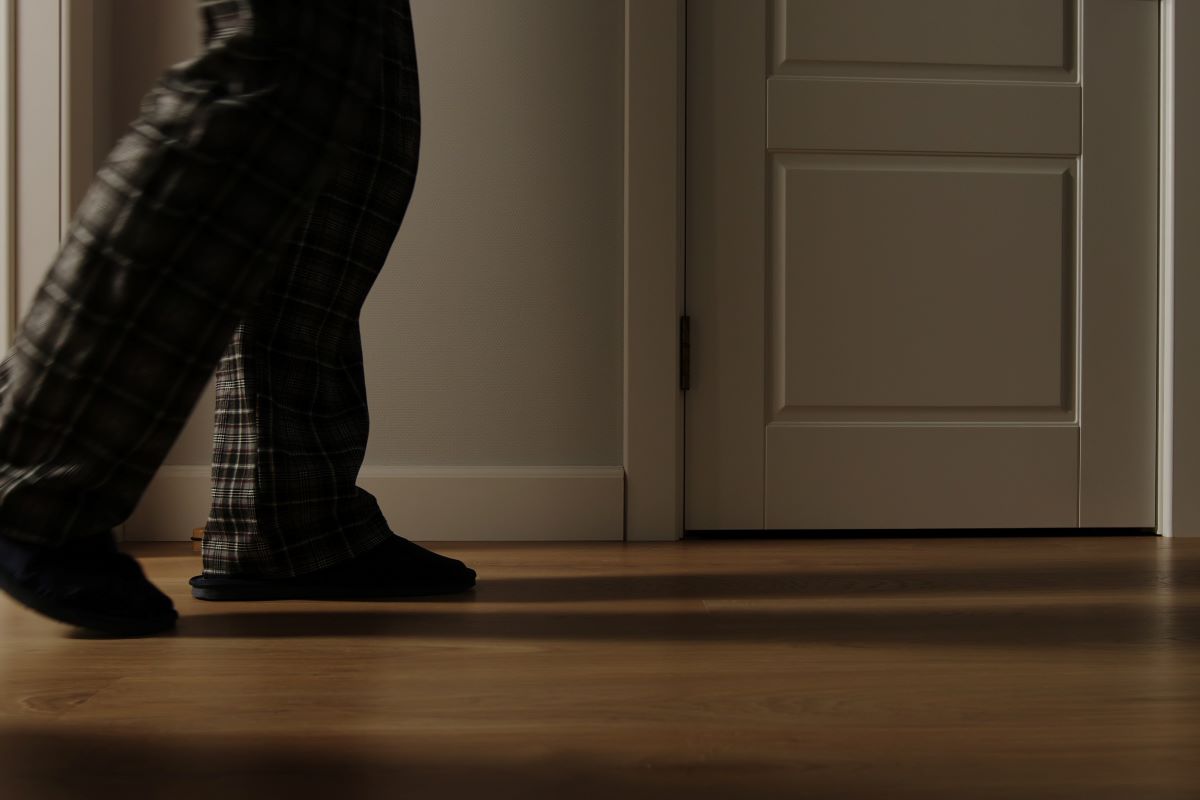Your Questions — 9 minutes
What is sleepwalking?
Sleepwalking is a type of parasomnia characterized by motor activity during the early stages of deep slow-wave sleep, usually one to three hours after falling asleep.

This sleep disorder, which is common in young children, tends to disappear in adolescence, although it may persist or reappear in adulthood. The prevalence of sleepwalking varies widely from study to study: from 4% to 17% in children and from 2% to 4% in adults. According to a meta-analysis of 51 different studies, 5% of children and 1.5% of adults reportedly experienced an episode of sleepwalking in the past 12 months.[1]
Causes of sleepwalking
Because sleepwalking is more common in children than in adults, researchers believe that this sleep disorder may be due to the fact that the child’s brain is not yet fully developed.
A number of factors can also trigger sleepwalking episodes, including:
- Fatigue
- Sleep deprivation
- Stress and anxiety
- Drug and alcohol use
- Excessive physical activity before sleep
- Nocturnal respiratory disorders
- Restless legs syndrome
- Internal and external stimuli (noise, full bladder, fever, etc.)
- Change of environment (moving, vacation)
Sleepwalking may also be explained by a hereditary factor. According to one study,[2] children who have a sleepwalking parent are three times more likely to develop sleepwalking behaviour than children who have not. This likelihood rises to seven if both parents have a history of sleepwalking.
Symptoms
During an episode of sleepwalking, the individual’s eyes are open and expressionless. They may simply sit up in bed, or get up and walk around – but not with arms outstretched as they are so often portrayed. They can do basic movements, such as opening a door, walking down stairs, or everyday tasks. This condition is mild but can put the person at risk of injury, especially if they decide to use tools, go outside the house or drive.
These occasional behaviours may last from one to 30 minutes, but rarely exceed 10 minutes. The individual may then wake up on their own or go back to bed. They will have no memory of what happened. Since it may be difficult (but not dangerous) to wake them up, it is preferable to gently guide them back to bed.
Diagnosis
Sleepwalking is usually diagnosed based on observations reported by the parents or loved ones of a sleepwalker. Individuals who suffer from sleepwalking may also notice their condition because of minor injuries (bruises or cuts) that they believe happened during a sleepwalking episode, or because of a disturbance in their environment when they wake up.
The health care professional will try to determine what is causing the sleepwalking or making the symptoms worse. They may recommend a polysomnography to identify another sleep disorder or confirm the diagnosis of sleepwalking.
In adults it is especially important to distinguish sleepwalking from REM sleep behaviour disorder. In this sleep disorder, the person acts out their dreams and the consequences are often quite dramatic.
Treatment
To reduce sleepwalking episodes, it is important to eliminate the factors that can trigger them. For example, you should try to prevent fatigue and avoid sleep deficits by adopting a healthy lifestyle and good sleep hygiene. If sleepwalking is caused by stress or anxiety, relaxation techniques or psychotherapy may be beneficial. You can also create a soothing sleep environment by eliminating noises and lights that could trigger an episode.
To avoid injury, it is important to make the environment safe by locking doors and windows, installing safety gates in front of stairways and, if necessary, using a device such as an alarm that will sound when someone is leaving their room. Another suggestion is to remove objects from the floor that could cause the person to trip, as well as remove potentially dangerous items, such as blunt objects, from the room.
When a child has frequent sleepwalking episodes that put their safety at risk, the scheduled awakenings method can improve the situation. This involves waking the child each night 15 to 30 minutes before the average time the episodes occur, for about one month. In adults, benzodiazepines (clonazepam) may be helpful, but they do not always control the episodes perfectly.
For professional support, we’re here for you.
We provide services that can help your doctor diagnose sleep disorders and determine the appropriate treatment.
You have questions about an equipment? Chat online with our respiratory therapist.
Sources2
- STALLMAN, Helen, and KOHLER, Mark. “Prevalence of Sleepwalking: A Systematic Review and Meta-Analysis,” PLoS One, Vol. 11, #11, p. e0164769, November 2016, https://journals.plos.org/plosone/article?id=10.1371/journal.pone.0164769.
- PETIT, Dominique, et al. “Childhood Sleepwalking and Sleep Terrors: A Longitudinal Study of Prevalence and Familial Aggregation,” JAMA Pediatrics, Vol. 169, #7, pp. 653-658, 2015, https://jamanetwork.com/journals/jamapediatrics/fullarticle/2281574.









